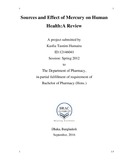Sources and effect of mercury on human health: a review

View/
Date
2016-09Publisher
BRAC UniveristyAuthor
Humaira, Kasfia TasnimMetadata
Show full item recordAbstract
Mercury is one of the common environmental toxicants that prevails on Earth naturally due
to soil erosion and volcanic eruption. This environmental pollutant is also released due to
different human activities, e.g., burning coals in power stations, Zinc-smelting, mining of
artisanal scale gold etc. There are different forms of mercury such as, elemental, organic,
inorganic etc. and they have multiple effects on human health upon consumption or
administration. There are different sources of mercury, for example, fish (e.g., shellfish,
swordfish), soil, etc. The fish bio-accumulates the mercury by feeding on smaller fishes and
planktons. The mercury presence in soil is due to the different anthropogenic activities and
later this mercury gets incorporated into the rice, grown in that soil. Mercury is also found in
thermometers, barometers, sphygmomanometers as well as electric devices, such as, electric
switches, relay equipment, lamps etc. Occupationally, people in dental clinics, choir alkali
plants and mercury nines and industries of pesticides and insecticides are exposed to
mercury. The major sources of occupational mercury are China, Spain, Kyrgyzstan, Algeria,
Russia, Slovakia etc. The element is non-toxic upon direct consumption but is poisonous if
its vapor or agitated form is inhaled. It is harmful to the lungs, liver, kidneys as well as the
nervous system. It is highly detrimental for both central and peripheral nervous system of
children. Fetuses are exposed to mercury through placental blood and nursing infants
consume mercury through mother’s milk and hence they suffer from major drawbacks too.
Upon inhalation of mercury vapor, it may cause bronchitis or pneumonitis as it has certain
necrotizing effects. Occupationally, dentists or choir alkali workers may suffer from
neurological, nephrological, immunological, cardiac, reproductive, motor and genetic
disorders. The review summarizes the physico-chemical properties of mercury. It highlights
the different visual and hidden sources of mercury available in our surroundings. It clearly
describes the pharmacokinetic and pharmacodynamics effects of mercury. It also mentions
how mercury poses threat to human health and population of different age-group. Finally,
there is a comparative study between Bangladesh and other countries where merecury
poisoning is most available due to the significant sources being present prominently.
